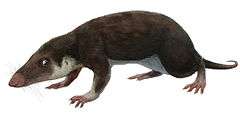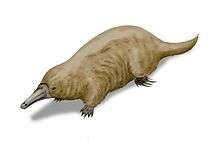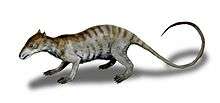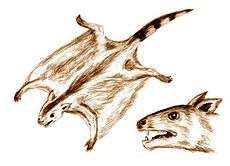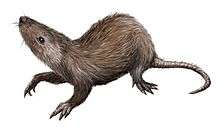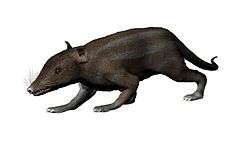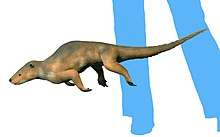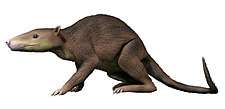Cimolodonta
The Cimolodonta are a taxon of extinct mammals that lived from the Cretaceous to the Eocene. They were some of the more derived members of the extinct order Multituberculata. They probably lived something of a rodent-like existence until their ecological niche was assumed by true rodents. The more basal multituberculates are found in a different suborder, "Plagiaulacida".
| Cimolodonta | |
|---|---|
 | |
| A reconstruction of Ptilodus | |
| Scientific classification | |
| Kingdom: | Animalia |
| Phylum: | Chordata |
| Class: | Mammalia |
| Order: | †Multituberculata |
| Suborder: | †Cimolodonta |
| Superfamilies | |
| |
Cimolodonta is apparently a natural (monophyletic) suborder. Remains have been identified from across the Northern Hemisphere. The taxon is recognized as the informal Paracimexomys group and the superfamilies Djadochtatherioidea, Taeniolabidoidea, and Ptilodontoidea. Additionally, and of uncertain affinities, are the families Cimolomyidae, Boffiidae, Eucosmodontidae, Kogaionidae, Microcosmodontidae and the two genera Uzbekbaatar and Viridomys. More precise placement of these types awaits further discoveries and analysis.
Taxonomy
Suborder †Cimolodonta McKenna, 1975
- Superfamily Incertae sedis
- Family Incertae sedis
- Subfamily Incertae sedis
- Genus? Ameribaatar Eaton & Cifelli, 2001
- Genus? Bryceomys Eaton, 1995
- Genus Cedaromys Eaton & Cifelli, 2001
- Genus? Dakotamys Eaton, 1995; (Early Cretaceous, Central North America)
- Genus? Fractinus Higgins, 2003
- Genus Halodon Marsh, 1889
- Genus Ptilodus (Marsh, 1889) Gidley, 1909
- Genus? Uzbekbaatar Kielan-Jaworowska & Nesov, 1992
- Genus? Barbatodon Rãdulescu & Samson, 1986
- Subfamily Incertae sedis
- Family Incertae sedis
- "Paracimexomys group" Archibald, 1982
- Genus Paracimexomys Archibald, 1982
- Genus? Cimexomys Fox, 1971
- Genus Cimexomys Sloan & Van Valen, 1965 sensu stricto?
- Family Boffiidae Hahn & Hahn, 1983
- Genus Boffius Vianey-Liaud, 1979
- Family Cimolomyidae Marsh, 1889 sensu Kielan-Jaworowska & Hurum, 2001
- Genus Essonodon Simpson, 1927
- Genus Buginbaatar Kielan-Jaworowska & Sochava, 1969
- Genus Meniscoessus Cope, 1882 (syn. Dipriodon Marsh, 1889, Tripriodon Marsh, 1889, Selenacodon Marsh, 1889, Halodon Marsh, 1889, Oracodon Marsh, 1889)
- Genus Cimolomys Marsh, 1889 (syn. ?Allacodon Marsh, 1889; Meniscoessus; Ptilodus; Selenacodon Marsh, 1889)
- Superfamily Ptilodontoidea Cope, 1887 sensu McKenna & Bell, 1997 & Kielan-Jaworowska & Hurum, 2001
- Family Cimolodontidae Marsh, 1889 sensu Kielan-Jaworowska & Hurum, 2001
- Genus Liotomus Lemoine, 1882
- Genus Essonodon Simpson, 1927
- Genus Anconodon Jepsen, 1940
- Genus Cimolodon Marsh, 1889 [syn. Nanomys Marsh, 1889, Nonomyops Marsh, 1892]
- Genus Neoliotomus Jepsen, 1930
- Family Ptilodontidae Cope, 1887 (syn Ptilodontinae Cope, 1887 sensu McKenna & Bell, 1997)
- Genus Kimbetohia Simpson, 1936
- Genus Ptilodus Cope, 1881 (Chirox Cope, 1884)
- Genus Baiotomeus Krause, 1987
- Genus Prochetodon Jepsen, 1940
- Family Neoplagiaulacidae Ameghino, 1890 (syn Neoplagiaulacinae Ameghino, 1890 sensu McKenna & Bell, 1997)
- Genus Mesodma Marsh, 1889
- Genus Ectypodus Matthew & Cranger, 1921 (Syn. Charlesmooria Kühne, 1969)
- Genus Mimetodon Jepsen, 1940
- Genus Neoplagiaulax Lemoine, 1882
- Genus Parectypodus Jepsen, 1930
- Genus Cernaysia Vianey-Liaud, 1986
- Genus Krauseia Vianey-Liaud, 1986
- Genus Xyronomys Rigby, 1980
- Genus Xanclomys Rigby, 1980
- Genus Mesodmops Tong & Wang, 1994
- Family Kogaionidae Rãdulescu & Samson, 1996
- Genus Barbatodon Rãdulescu & Samson, 1996
- Genus Hainina Vianey-Liaud, 1979
- Genus Kogaionon Rãdulescu & Samson, 1996
- Family Eucosmodontidae Jepsen, 1940 sensu Kielan-Jaworowska & Hurum, 2001 (syn. Eucosmodontinae Jepsen, 1940 sensu McKenna & Bell, 1997)
- Genus Clemensodon Krause, 1992
- Genus Eucosmodon Matthew & Granger, 1921
- Genus Stygimys Sloan & Van Valen, 1965
- Family Microcosmodontidae Holtzman & Wolberg, 1977 (syn Microcosmodontinae Holtzman & Wolberg, 1977 McKenna & Bell, 1997)
- Genus Pentacosmodon Jepsen, 1940
- Genus Acheronodon Archibald, 1982
- Genus Microcosmodon Jepsen, 1930
- Family Cimolodontidae Marsh, 1889 sensu Kielan-Jaworowska & Hurum, 2001
- Superfamily Djadochtatherioidea Kielan-Jaworowska & Hurum, 1997 sensu Kielan-Jaworowska & Hurum, 2001 (syn Djadochtatheria Kielan-Jaworowska & Hurum, 1997)
- Genus? Bulganbaatar Kielan-Jaworowska, 1974
- Genus? Chulsanbaatar Kielan-Jaworowska, 1974
- Genus Nemegtbaatar Kielan-Jaworowska, 1974
- Family Sloanbaataridae Kielan-Jaworowska, 1974
- Genus Kamptobaatar Kielan-Jaworowska, 1970
- Genus Nessovbaatar Kielan-Jaworowska & Hurum, 1997
- Genus Sloanbaatar Kielan-Jaworowska, 1974
- Family Djadochtatheriidae Kielan-Jaworowska & Hurum, 1997
- Genus Djadochtatherium Simpson, 1925
- Genus Catopsbaatar Kielan-Jaworowska, 1974
- Genus Tombaatar Kielan-Jaworowska, 1974
- Genus Kryptobaatar Kielan-Jaworowska, 1970 (syn Gobibaatar Kielan-Jaworowska, 1970, Tugrigbaatar Kielan-Jaworowska & Dashzeveg, 1978)
- Superfamily Taeniolabidoidea Granger & Simpson, 1929 sensu Kielan-Jaworowska & Hurum, 2001
- Genus Prionessus Matthew & Granger, 1925
- Family Taeniolabididae Granger & Simpson, 1929
- Genus Kimbetopsalis Sarah, 2015
- Genus Taeniolabis Cope, 1882
- Family Lambdopsalidae
- Genus Sphenopsalis Matthew, Granger & Simpson, 1928
- Genus Lambdopsalis Chow & Qi, 1978
